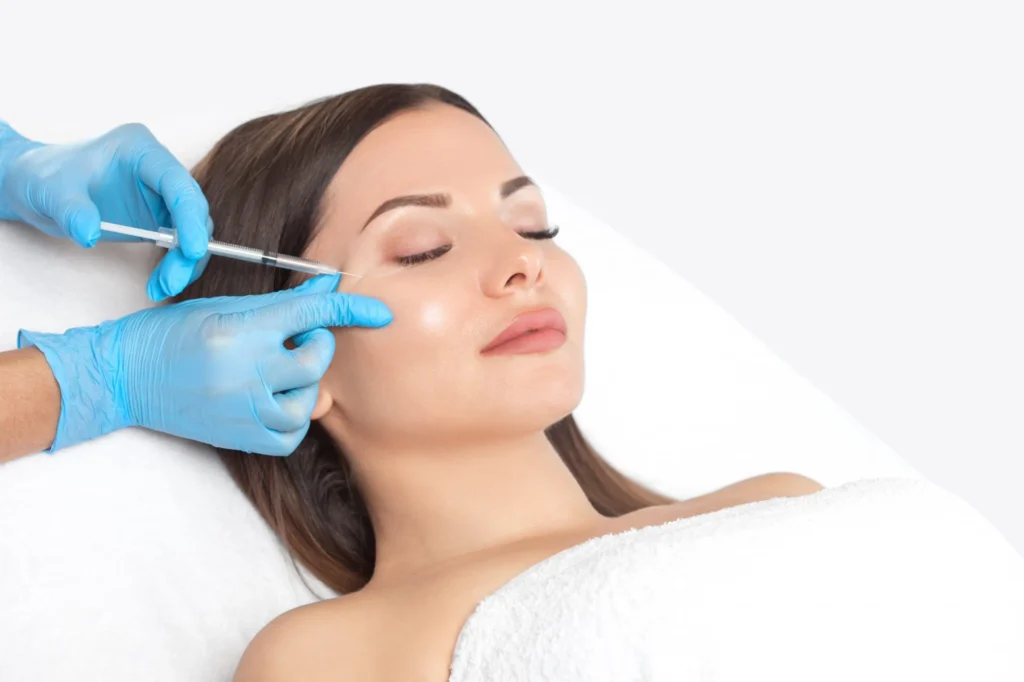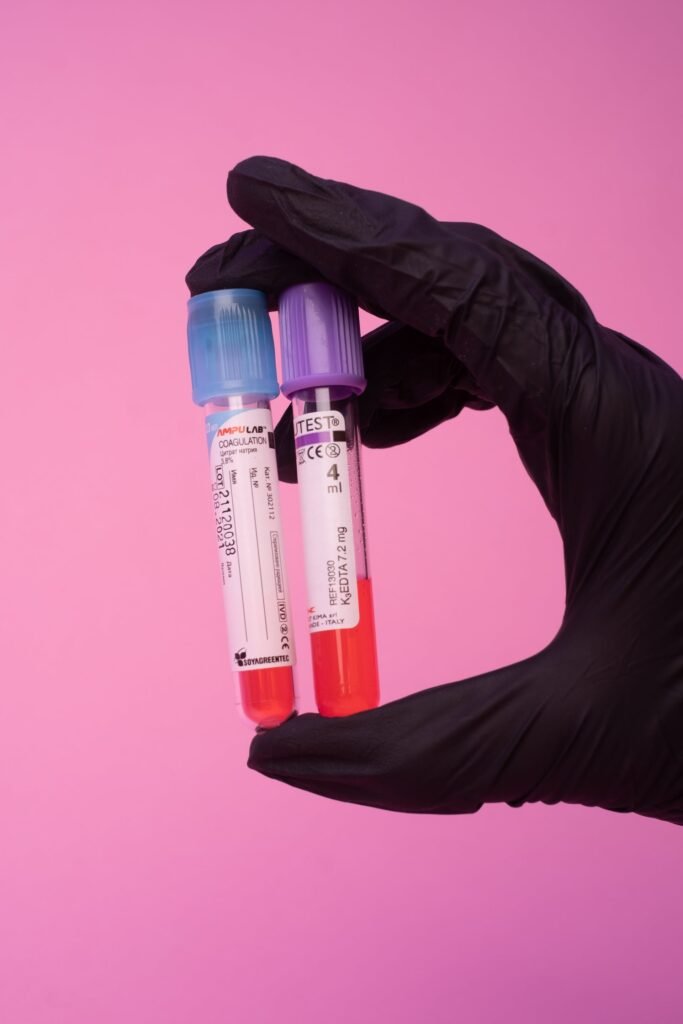

Platelet Rich Plasma (PRP) For Hair Growth
PRP injections work by using your own blood plasma to stimulate hair growth. Plasma is the clear liquid component of your blood that contains platelets – cells that are responsible for clotting and healing wounds. When injected into the scalp, PRP helps to trigger new hair growth and thicken existing hair follicles.
PRP Hair Restoration – Pre-care Instructions:
- Avoid NSAID use 1 week prior to procedure (Alleve, Ibuprofen, Naproxen, Advil etc).
- Please discontinue blood thinning agents such as vitamin A, Ginkgo, Garlic, Flax, Cod Liver Oil, Omega 3 Fatty Acids, and multivitamins, a minimum of 7 days (preferably 14 days) prior to treatment
- You may take Tylenol as needed prior to the treatment
- Avoid colouring hair 2 weeks prior to procedure.
- Please prepare for the procedure by eating a full meal at least 2-3 hours before hand
- Avoid excessive sun or heat exposure 5-7 days prior to treatment
- Minimize or avoid alcohol 3 days prior to treatment
- 8-10oz glasses of water the day before your treatment session.
- The procedure typically takes 45 – 60 minutes
- The procedure typically takes 45 – 60 minutes
PRP Hair Restoration- The Morning of Your Treatment:
- Shower the morning of your treatment and wash your hair very thoroughly using your regular shampoo. Do not apply sprays, gels, or any other styling products to your hair
- If you wear a hair system, please remove it prior to shampooing and do not wear it before your PRP treatments.
- Please eat a normal breakfast or lunch the day of your PRP session
- Please drink 8-10 oz of water at least 2 hours prior to your treatment
Post-care Instructions:
- Avoid NSAID use 1 week after the treatment.
- We would prefer that you avoid applying ice to the injected area, as ice acts as an anti-inflammatory
- Do not touch, press, rub or manipulate the treated area(s) for at least 8 hours after your treatment
- Use regular Tylenol following the procedure if needed for pain associated with procedure
- Avoid coloring hair 2 weeks after treatment
- Do not wet your hair for at least 3 hours after your treatment
- For the first 3 days, use shampoo that is pH balanced.
- Do not use any hair products for at least 6 hours after your treatment
- Avoid saunas, steam rooms, swimming for 2 days after your treatment
- Avoid vigorous exercise, sun and heat exposure for at least 2 days after your treatment
- Avoid alcohol, caffeine, and smoking for 3 days after treatment
- Smokers do not heal well and problems re-occur earlier and results may take longer
- Continue to increase water intake the first week after treatment
- Please do not hesitate to call our office should you have any questions or concerns regarding your PRP treatment or aftercare
- We will follow-up with you, day 3& day 7 after your procedure (depending on your choice of contact)
- To truly maximize your results, it is recommended to incorporate supplements with your hair restoration process
What to expect after treatments:
- Lingering soreness of scalp x 24-48hrs
- Slowing of hair shedding and gradual hair growth and over next 3-6 months
- New hair growth typically noticed after the 3rdor 4th treatment, with maximum effect occurring 3-9 months following 3rd treatment.
- Treatment effects, with potential for continued improvement, persist 6-12 months after last treatment
- While we cannot guarantee regrowth of new hair, rate of hair loss drastically declines, while receiving treatments and for an average of 6-12 months following the last procedure
Potential Risks
- It is normal to experience bruising, redness, itching, swelling and/or soreness that may last 2 days following your treatment. If you experience any pain or discomfort, you may take Tylenol or other Acetaminophen- containing products as directed.
- Allergic response or anaphylaxis to anesthetics
- Nerve damage from injections
- Risk of infection at injection site
Platelet Rich Plasma (PRP) Facial
Is an injection treatment whereby a person’s own blood is used. A fraction of blood (20cc or more, dependent on the area to be treated) is drawn up from the individual patient into a syringe. This is a relatively small amount compared to blood donation which can remove 500cc. The blood is spun in a special centrifuge to separate its components (Red Blood Cells, Platelet Rich Plasma, Platelet Poor Plasma and Buffy Coat). Platelets are very small cells in your blood that are involved in the clotting and healing process. These platelets are then injected back into your face using microneedling or mesotherapy needles. When PRP is injected into the damaged area it causes a mild inflammation that triggers the healing cascade. As the platelets organize in the treatment area, they release a number of enzymes to promote healing and tissue responses including attracting stem cells and growth factors to repair the damaged area. As a result, new collagen begins to develop. As the collagen matures it begins to shrink causing the tightening and strengthening of the damaged area. When treating injured or sun and time damaged tissue, they can induce a remodeling of the tissue to a healthier and younger state. The full procedure takes approximately 45 minutes to an hour. Generally, 3-4 treatments are advised, however, more may be necessary for some individuals. Touch up treatments may be done once a year after the initial group of treatments to boost and maintain the results.
PRP’S Safety: has been established for over 20 years for its wound healing properties and its proven effectiveness has extended across multiple medical specialties including cardiovascular surgery, orthopedics, sports medicine, podiatry, ENT, neurosurgery, dental and maxillofacial surgery (dental implants and sinus elevations), urology, dermatology (chronic wound healing), and ophthalmology, cosmetic surgery. PRP’s emergence into aesthetics and skin rejuvenation began i n 2004 in Europe, Asia, Australia, and South America in countries such as The United Kingdom, Japan, Spain, Portugal, Switzerland and Argentina to name a few. Areas typically treated for aesthetic purposes and skin rejuvenation include: Crinkling skin around the eyes, cheeks and midface,
neck, jaw-line, chest and décolletage, back of hands and arms, lips, and to stimulate hair growth on scalp. Almost all skin tones show that PRP is safe and effective because your own enriched plasma is used.
Benefits of PRP:
Along with the benefit of using your own tissue therefore virtually eliminating allergies, there is the added intrigue of mobilizing your own stem cells for your benefit. PRP has been shown to have overall rejuvenating effects on the skin including: improving skin texture, thickness, fine lines and wrinkles, increasing volume via the increased production of collagen and Elastin, and by diminishing and improving the appearance of scars. The most dramatic results to date have been the crepey skin problems in areas such as under the eyes, neck, and décolletage. It is not designed to replace cosmetic surgery as there are some cases where t hose procedures wo u l d b e more appropriate. Other benefits include: minimal down time, safe with minimal risk, short recovery time, natural looking results; no general anesthesia is required.
Contraindications:
PRP used for aesthetic procedures is safe for most individuals between the ages of 18-80. There are very few contraindications, however, patients with the following conditions are not candidates: 1) Acute and Chronic Infections, 2) Skin diseases (i.e. SLE, porphyria, allergies), 3) Cancer, 4) Chemotherapy treatments, 5 ) Severe metabolic and systemic disorders, 6) Abnormal platelet function (blood disorders, i.e. Haemodynamic Instability, Hypofibrinogenemia, Critical Thrombocytopenia), 7) Chronic Liver Pathology, 8) Anti-coagulation therapy, 9) Underlying Sepsis ,and 10) Systemic use of corticosteroids within two weeks of the procedure.
Risks & Complications:
Some of the Potential Side Effects of Platelet Rich Plasma include: 1) Pain at the injection site; 2) Bleeding, Bruising and/or Infection as with any type of injection; 3) Short lasting pinkness/redness (flushing) of the skin; 4) Allergic reaction to the solution; 5) Injury to a nerve and/or muscle as with any type of injection; 6) Itching at the injection site(s); 7) Nausea /vomiting; ( The following are possible with any simple injection and not specific to PRP Therapy).8) Dizziness or fainting;
9) Temporary blood sugar increase; 10) Swelling; 11) Minimal effect from the treatment.
Alternatives to PRP:
Alternatives to PRP are: 1) Do Nothing; 2) Surgical intervention may be a possibility; 3) Injections with neurotoxins; 4) Injections of dermal filling agents; 5) Laser & light-based treatments like Pulsed Light; 6) chemical peels.
Results:
Results are generally visible at 3-4 weeks and continue to improve gradually over ensuing months (3-6) with improvement in texture and tone. Advanced wrinkling cannot be reversed and only a minimal improvement is predictable in persons with drug, alcohol, and tobacco usage. Severe scarring may not respond. Current data shows results may last 18·24 months. Of course, all individuals are different so there will be variations from one person to the next.
Neuromodulators (Dysport)
Neuromodulators are arguably the most well-known sort of cosmetic injection. They are mostly used to treat wrinkles and fine lines by temporarily paralyzing the muscles that causes them.
Dermal fillers
Are injected into the skin to fill in wrinkles and fine lines, as well as to give volume to areas of the face that have lost volume over time. Dermal fillers are composed of a range of ingredients, which include hyaluronic acid, collagen etc. Dermal fillers, unlike neuromodulators, might last months or even years.
Skin boosters
Are injections that contain a cocktail of vitamins, minerals, and antioxidants that work to improve the overall health and appearance of your skin. Skin boosters can be used to treat a variety of concerns, including fine lines, wrinkles, uneven skin tone, and dryness. Call us or book appointment for your consultation
